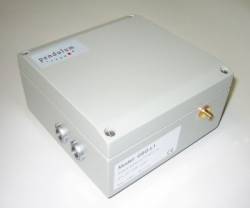 TI NavLink 6.0
TI NavLink 6.0Texas Instruments’s (TI’s) announcement of its NaviLink 6.0 (NL5500) with integrated GPS, Bluetooth, and FM may presage the company’s expanded focus for application markets beyond cell phone handsets.
Texas Instruments’s (TI’s) announcement of its NaviLink 6.0 (NL5500) with integrated GPS, Bluetooth, and FM may presage the company’s expanded focus for application markets beyond cell phone handsets.
Introduced at CTIA Wireless 2008, the chip combines low-power assisted-GPS (A-GPS), Bluetooth 2.1, and FM receive/transmit capabilities. NaviLink 6.0 includes patent-pending algorithms to reduce the time to first fix by up to 80 percent over previous TI solutions. Integrated “position optimizer” software is designed to improve accuracy in weak satellite signal areas, such as urban centers and heavily wooded areas.
Built using TI’s 65-nanometer chip and DRP single-chip manufacturing processes, NavLink 6.0 reduces board space by up to 40 percent and power consumption, by up to 50 percent over previous TI solutions, accordiung to the company. The current generation GPS chipe, the NL5350 NaviLink 5.0, takes up about 25 square millimeters.
“NaviLink 6.0 enables TI’s customers to further enhance the mobile user experience by bringing popular GPS functionality and mobile connectivity to broader market segments,” said Remi El-Ouazzane, vice president of TI’s Wireless Terminals Business Unit.
Among other customers, in recent years TI has supplied Nokia with chips for many of its cell phones. Handsets withNaviLink 6.0 are expected to be on the market by the second half of 2009, according to the company.
In combining GPS with other RF technologies, TI reflects a growing trend among wireless semiconductor manufacturers, some of which have acquired OEM GPS technology companies in recent years to add to their existing RF.
Examples of these include Qualcomm (acquired SnapTrack in 2000), RFMD (IBM Semiconductors’ GPS business, 2001), CSR (NordNav, 2007), Broadcom (Global Locate, 2007), NXP Semiconductors (GloNav, 2007), and Atheros (uNav Microelectronics, 2007).
TI, of course, developed its GPS technology with internal resources rather than by an acquisition. Although unrecognized by many who have come to the field more recently, the Dallas-based company actually has a long history in GPS technology going back to the 1970s with development of the Manpack/Vehicular User Equipment for the Department of Defense and the first commercial GPS survey equipment, the TI 4100 NAVSTAR Navigator Multiplex Receiver, introduced in 1982.



